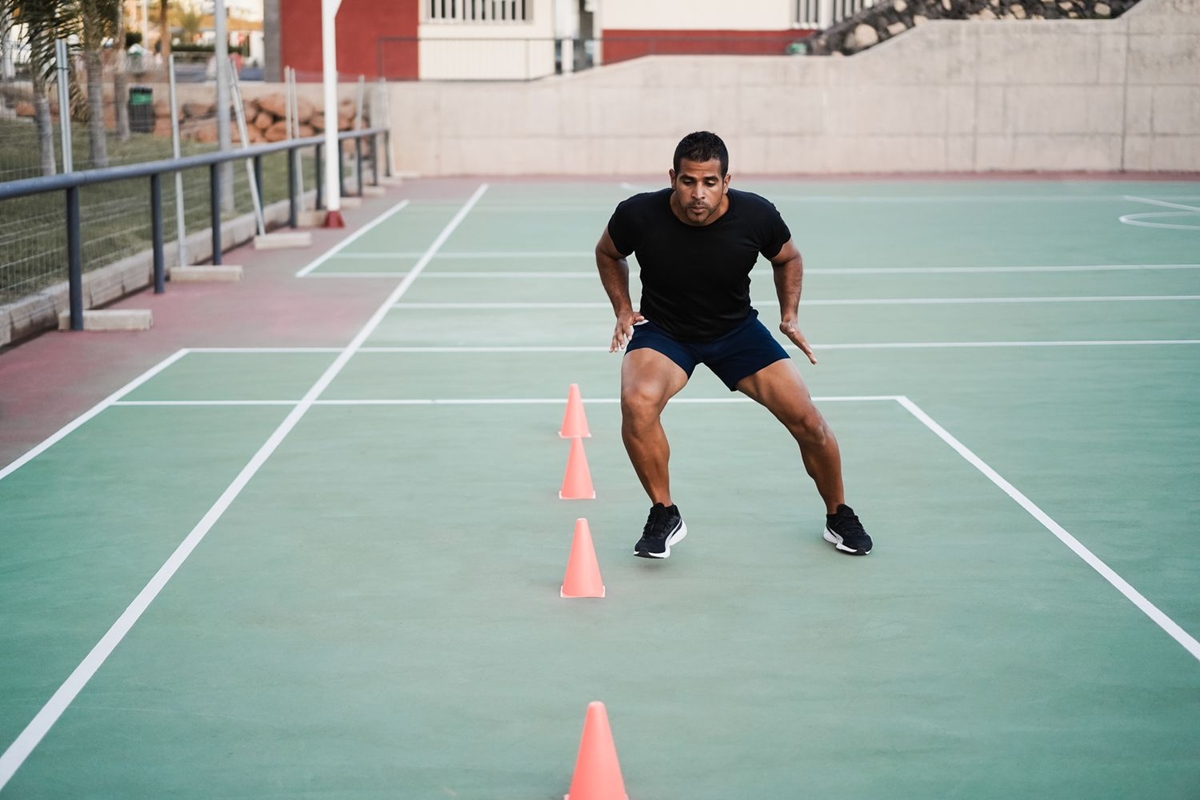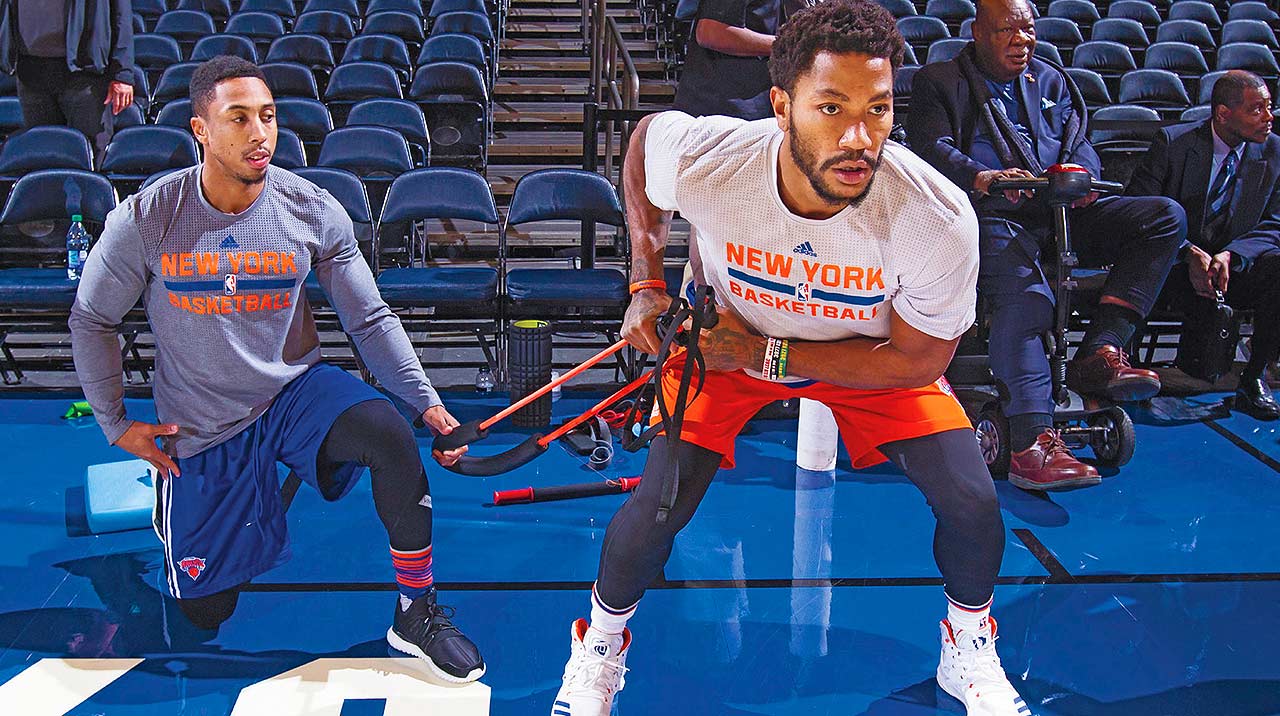

Featured
What Does Battle Rope Workout
Modified: August 21, 2023
Discover the benefits of the featured battle rope workout and get in the best shape of your life. Transform your fitness routine with intense and effective full-body exercises.
Introduction
Are you looking for a challenging and effective workout that will push your limits and help you achieve your fitness goals? Look no further than the battle rope workout. Battle ropes have become increasingly popular in recent years due to their ability to provide a full-body workout that combines strength, endurance, and cardio.
The concept of battle rope workouts originated from traditional training techniques used by the navy and the military. In the past, battle ropes were primarily used for conditioning and building strength in athletes. However, today they have made their way into mainstream fitness and are embraced by people of all fitness levels.
So, what exactly is a battle rope workout? It involves using long, heavy ropes that are anchored to a sturdy structure or wrapped around an object such as a tree or pole. By gripping the ends of the ropes and performing a variety of movements, you engage multiple muscle groups simultaneously, creating a high-intensity workout.
The beauty of battle rope workouts lies not only in their intensity but also in their versatility. You can customize your workout by adjusting the length and thickness of the ropes, as well as the intensity and duration of each exercise. With battle ropes, the possibilities are endless.
In this article, we will explore the benefits of incorporating battle rope workouts into your fitness routine, the specific muscle groups targeted, various techniques and exercises, tips for a successful workout, safety considerations, and even provide you with a sample battle rope workout routine.
Get ready to unleash your inner warrior and take your fitness journey to new heights with the exciting world of battle rope workouts.
Benefits of Battle Rope Workouts
Battle rope workouts offer a multitude of benefits for individuals of all fitness levels. Whether you’re a beginner or an experienced athlete, incorporating battle ropes into your fitness routine can take your workout to the next level. Here are some of the key benefits you can expect:
- Full-Body Workout: One of the greatest advantages of battle rope workouts is their ability to engage multiple muscle groups simultaneously. As you perform various exercises, you work your arms, shoulders, back, core, and legs, ensuring you get a comprehensive full-body workout.
- Strength and Endurance: Battle rope exercises are excellent for building strength and endurance. The constant tension and resistance provided by the ropes challenge your muscles and help you develop greater overall strength and stamina. Regular battle rope training can lead to improved muscle tone and increased muscle mass.
- Cardiovascular Health: Battle rope workouts are intense and require continuous effort, making them excellent for improving cardiovascular fitness. By incorporating battle ropes into your routine, you can boost your heart rate, increase oxygen intake, and improve your cardiovascular endurance.
- Weight Loss and Fat Burning: Battle rope workouts are highly effective for burning calories and shedding excess body fat. These high-intensity exercises elevate your heart rate and ramp up your metabolism, leading to increased calorie expenditure even after your workout. Regular battle rope training can contribute to weight loss and help you achieve a leaner physique.
- Improves Core Stability and Balance: Many battle rope exercises require a solid and stable core. By engaging your core muscles during these workouts, you can strengthen your abdominal muscles, improve stability, and enhance overall balance.
- Enhances Coordination and Agility: Battle rope exercises involve performing various movements, often in an alternating or wave-like pattern. This constant coordination challenge improves your overall agility, hand-eye coordination, and motor skills.
- Low-Impact Option: Battle rope workouts are a low-impact alternative to high-impact exercises like running or jumping. This makes them suitable for individuals with joint issues or those looking for a low-impact workout that is still challenging and effective.
By incorporating battle rope workouts into your fitness routine, you can experience these incredible benefits and take your fitness journey to new heights. Whether your goal is to build strength, improve endurance, or lose weight, battle ropes can provide the dynamic and engaging workout you’re looking for.
Muscle Groups Targeted
Battle rope workouts are a phenomenal way to work multiple muscle groups simultaneously. The dynamic and challenging nature of the exercises engages various muscles throughout your body. Here are some of the primary muscle groups targeted during a battle rope workout:
- Shoulders and Arms: Battle rope exercises heavily target the muscles in your shoulders and arms. Movements like waves, slams, and circles require you to generate force from these muscles, leading to improved strength and definition in your deltoids, biceps, and triceps.
- Back and Core: As you perform battle rope movements, your back and core muscles are constantly engaged to maintain stability and generate power. The rectus abdominis, obliques, erector spinae, and other muscles in your back and abdomen get activated, leading to improved core strength and stability.
- Chest and Upper Body: Several battle rope exercises, such as alternating waves and rope push-ups, target the muscles in your chest and upper body. These movements help strengthen your pectoral muscles, trapezius, and deltoids, giving you a more defined and sculpted upper body.
- Legs and Glutes: Although battle rope exercises primarily focus on the upper body, you can engage your lower body as well. Exercises like squats, lunges, and jump slams require you to use your leg muscles, including quadriceps, hamstrings, and glutes, resulting in improved lower body strength and stability.
- Cardiovascular System: Battle rope workouts are a great way to improve your cardiovascular fitness. When you perform these exercises with high intensity, your heart rate increases, and your cardiovascular system is challenged. This leads to improved heart health, increased stamina, and enhanced endurance.
By incorporating battle rope workouts into your fitness routine, you can effectively target and strengthen multiple muscle groups. The constant tension and resistance provided by the battle ropes ensure that you get a well-rounded workout that benefits both the upper and lower body, as well as the cardiovascular system.
Techniques and Exercises
Battle rope workouts offer a wide variety of techniques and exercises that can be tailored to suit your fitness level and goals. Here are some popular techniques and exercises you can incorporate into your battle rope routine:
- Alternating Waves: Stand with your feet shoulder-width apart, hold one end of the battle rope in each hand, and face the anchor point. Begin by creating a wave-like motion with the ropes, moving one arm up while the other goes down. Continue alternating the waves for a set period of time.
- Double Arm Slams: Assume a slightly squatting position with your feet shoulder-width apart and the battle ropes in each hand. Lift the ropes overhead and forcefully slam them down to the ground. Repeat this movement in a controlled manner for a designated number of reps.
- Jump Slams: Begin by performing double arm slams, but as you raise the ropes overhead, explosively jump vertically and slam the ropes down as you land. This exercise adds a plyometric element to your workout, helping to increase power and cardiovascular demand.
- Rope Circles: Hold onto the ropes with your arms extended in front of you. Keeping your arms straight, create circular motions in both clockwise and counterclockwise directions. This exercise targets the shoulders, arms, and core muscles, while also improving coordination and range of motion.
- Rope Grappler Throws: Assume a staggered stance with one foot in front of the other and hold onto the battle ropes with both hands. Similar to a squatting motion, explosively rotate your torso and throw the ropes to one side, imitating a “grappler” throwing a punch. Alternate sides with each repetition.
- Squat to Alternating Waves: Begin in a squat position with the ropes in each hand. Lower yourself into a deep squat and then as you stand back up, simultaneously perform the alternating waves. This exercise combines lower body strength training with upper body conditioning.
- Lateral Waves: Stand with your feet wider than shoulder-width apart and hold onto the ropes with your arms extended out to the sides. Create wave-like motions with the ropes, moving your arms in a side-to-side fashion. This exercise targets the shoulders, arms, and core, while also engaging the hip muscles.
These are just a few examples of the many techniques and exercises that can be performed with battle ropes. Feel free to experiment, combine movements, and adjust the intensity to keep your workouts challenging and varied. Remember to maintain proper form and engage your core throughout each exercise to maximize the benefits and prevent injuries.
Tips for a Successful Battle Rope Workout
To get the most out of your battle rope workout and ensure a safe and effective training session, consider these tips:
- Start Slow and Progress Gradually: If you’re new to battle rope workouts, start with shorter sets and lighter ropes. As your strength and endurance build, gradually increase the duration and intensity of your exercises.
- Focus on Form and Technique: Proper form is key to getting the most out of each exercise and reducing the risk of injury. Prioritize maintaining good posture, engaging your core, and using a full range of motion with each movement.
- Vary Your Intensity: Mix up your battle rope workouts by incorporating high-intensity intervals and lower-intensity recovery periods. This helps to challenge your cardiovascular system, burn more calories, and improve your overall fitness.
- Don’t Forget to Breathe: It’s crucial to maintain a steady and controlled breathing pattern throughout your battle rope workout. Focus on breathing deeply and exhaling during the exertion phase of each exercise.
- Stay Hydrated: Battle rope workouts can be intense and sweat-inducing, so it’s essential to stay properly hydrated. Drink water before, during, and after your workout to replenish fluid levels and optimize performance.
- Combine Battle Ropes with Other Exercises: Enhance the versatility of your workouts by incorporating battle ropes with other exercises like burpees, lunges, or bodyweight exercises. This helps to create a more well-rounded fitness routine and engage different muscle groups.
- Listen to Your Body: Pay attention to how your body feels during and after a battle rope workout. If you experience pain or extreme discomfort, adjust your technique or rest if needed. Push yourself, but always prioritize your safety and well-being.
- Warm Up and Cool Down: Before starting your battle rope workout, spend a few minutes engaging in dynamic stretching and a light warm-up to prepare your muscles. Similarly, cool down with static stretching and gentle movements to aid in muscle recovery and prevent stiffness.
- Invest in Quality Battle Ropes: Ensure you have durable and high-quality battle ropes to avoid fraying or snapping during your workouts. Invest in ropes that are the appropriate length and thickness for your fitness level and goals.
By keeping these tips in mind, you can maximize the effectiveness of your battle rope workout and minimize the risk of injuries. Remember that consistency is key, so aim to incorporate battle rope training into your fitness routine regularly to see progress and achieve your fitness goals.
Safety Considerations
While battle rope workouts can be highly beneficial, it’s important to prioritize safety to prevent injuries and ensure a successful training session. Consider the following safety considerations when incorporating battle ropes into your fitness routine:
- Start with Proper Instruction: If you’re new to battle rope workouts, seek guidance from a qualified fitness professional to learn proper form, technique, and safety precautions. Understanding the correct way to perform exercises will minimize the risk of injury.
- Choose the Right Surface: Perform your battle rope workouts on a suitable surface that provides good traction and stability. Avoid areas with loose or slippery flooring to minimize the risk of falls or accidents.
- Check the Anchoring Point: Ensure that the anchor point you use for securing the battle ropes is stable and secure. Whether it’s a sturdy post, wall, or piece of gym equipment, make sure it can handle the tension and force generated during the exercises.
- Use Protective Flooring: When performing high-intensity battle rope exercises, consider using mats or other protective flooring to cushion impact and reduce potential discomfort or injury to your joints.
- Be Mindful of Overexertion: While battle rope workouts can be intense, listen to your body and avoid pushing yourself beyond your limits. Gradually increase the duration and intensity of your workouts to prevent overexertion and reduce the risk of muscle strains or joint injuries.
- Dress Appropriately: Wear comfortable clothing that allows for a wide range of motion during battle rope exercises. Opt for supportive athletic shoes to provide stability and protect your feet during the workout.
- Pay Attention to Grip: Ensure you have a firm grip on the battle ropes to prevent them from slipping out of your hands during exercises. You may consider wearing gloves to improve your grip and mitigate the risk of developing blisters or calluses.
- Stay Hydrated: Proper hydration is crucial during any workout, including battle rope exercises. Drink enough water before, during, and after your workout to prevent dehydration and maintain optimal performance.
- Listen to Your Body: If you experience pain, discomfort, or any unusual sensations during a battle rope workout, stop and assess the situation. It’s important to listen to your body and understand when to modify or discontinue an exercise to prevent further injury.
Remember, safety should always be a top priority when engaging in any form of exercise. By following these safety considerations, you can minimize the risk of injuries and make the most of your battle rope workouts.
Sample Battle Rope Workout Routine
A well-structured battle rope workout routine can help you make progress towards your fitness goals while incorporating variety and intensity. Here’s an example of a sample battle rope workout routine:
- Warm-Up: Begin with a gentle warm-up to prepare your muscles for the workout. This can include dynamic stretching, light jogging, or jumping jacks for 5-10 minutes.
- Exercise 1: Alternating Waves (Duration: 1 minute)
Stand with your feet shoulder-width apart and grip the battle ropes with each hand. Alternate swinging your arms up and down, creating wave-like motions in the ropes. Focus on maintaining a steady and consistent pace throughout the duration. - Exercise 2: Double Arm Slams (Reps: 12-15)
Assume a squat position with the ropes held in both hands. Lift the ropes overhead and forcefully slam them into the ground, bringing them back up for the next repetition. Keep the movement controlled and engage your core throughout. - Exercise 3: Rope Circles (Duration: 45 seconds)
Hold onto the ropes with your arms extended in front of you. Create circular motions in both clockwise and counterclockwise directions, focusing on a smooth and controlled movement. Engage your core and maintain proper posture throughout the exercise. - Exercise 4: Rope Grappler Throws (Reps: 10-12 each side)
Assume a staggered stance with one foot in front of the other and hold onto the battle ropes with both hands. Explosively rotate your torso, twisting at the hips, and throw the ropes to one side as if throwing a punch. Alternate sides with each repetition. - Exercise 5: Squat to Alternating Waves (Reps: 10-12)
Start in a squat position with the battle ropes in each hand. Lower yourself into a deep squat and, as you stand back up, simultaneously perform the alternating wave motion. Focus on maintaining proper form and engaging your leg and core muscles throughout. - Exercise 6: Lateral Waves (Duration: 45 seconds)
Stand with your feet wider than shoulder-width apart and hold onto the ropes with your arms extended out to the sides. Create wave-like motions with the ropes, moving your arms in a side-to-side fashion. Engage your core and maintain a consistent rhythm throughout. - Cool-Down: Finish your battle rope workout with a cool-down to gradually lower your heart rate and stretch your muscles. Perform static stretches for each major muscle group, holding each stretch for 15-30 seconds.
Remember, this sample workout routine is just an example, and you can customize it to suit your fitness level and goals. You can increase or decrease the duration and intensity of each exercise or add more exercises to create a longer workout. Always ensure proper form, listen to your body, and adapt the routine as needed to continue challenging yourself and making progress.
Conclusion
Battle rope workouts offer a challenging and effective way to improve strength, endurance, and cardiovascular fitness. The dynamic and versatile nature of battle ropes allows you to target multiple muscle groups simultaneously, making it a popular choice for individuals of all fitness levels.
Incorporating battle ropes into your fitness routine can provide a multitude of benefits. You can expect a full-body workout that engages your upper body, core, and lower body muscles. The combination of strength training and cardiovascular exercise helps you build lean muscle, burn calories, and improve overall fitness.
When performing battle rope exercises, it’s important to prioritize safety and proper technique. Start slowly, progress gradually, and maintain good form throughout each movement. By following safety precautions and listening to your body, you can minimize the risk of injuries and optimize your workout experience.
Remember that consistency is key. Aim to incorporate battle rope workouts into your regular fitness routine to reap the benefits. Challenge yourself by varying the intensity, trying new exercises, and gradually increasing the workload. Always consult with a fitness professional if you’re new to battle rope workouts or have any specific concerns or limitations.
So, if you’re ready to take your fitness journey to the next level, grab those battle ropes and unleash your inner warrior. With dedication, effort, and the right technique, you can achieve your fitness goals and experience the incredible results that battle rope workouts have to offer.








